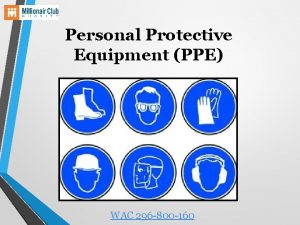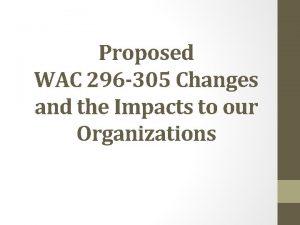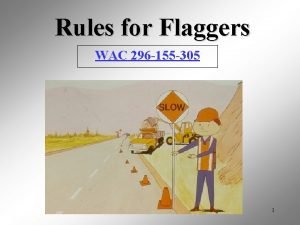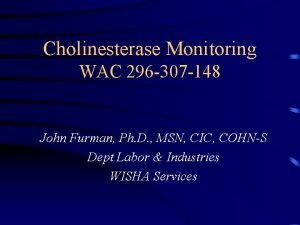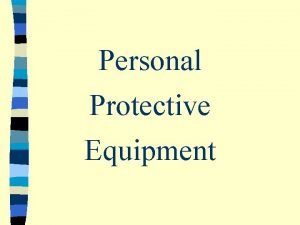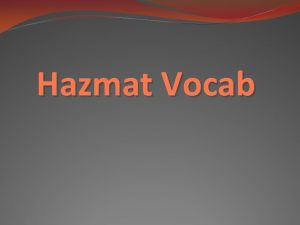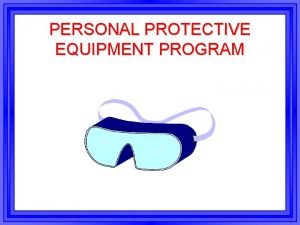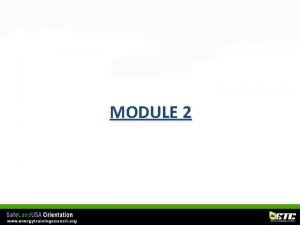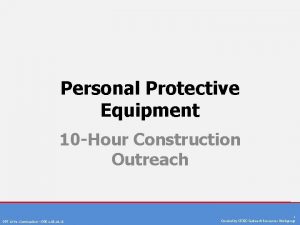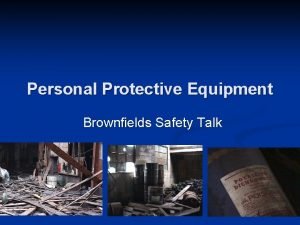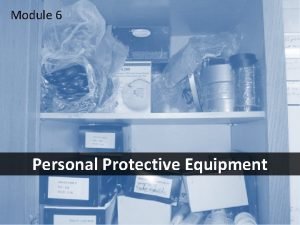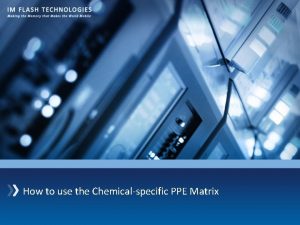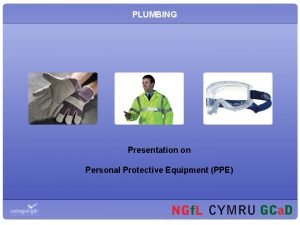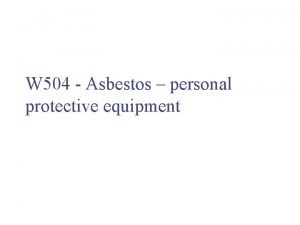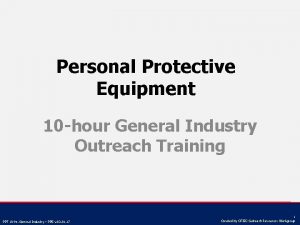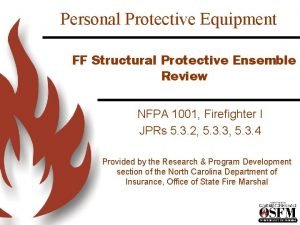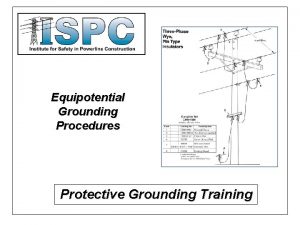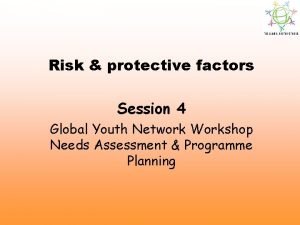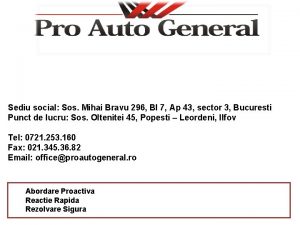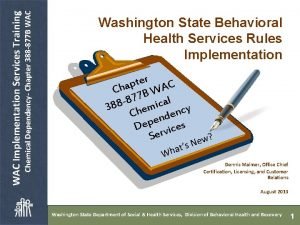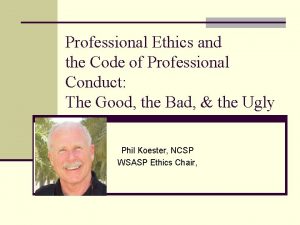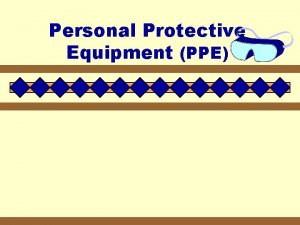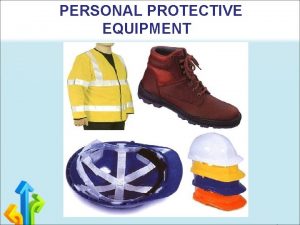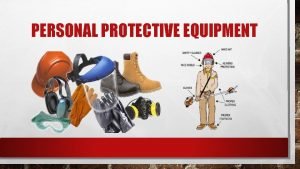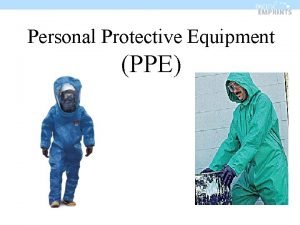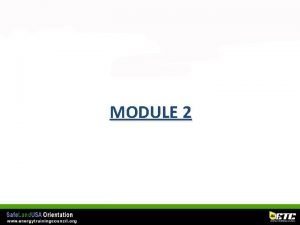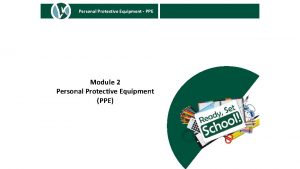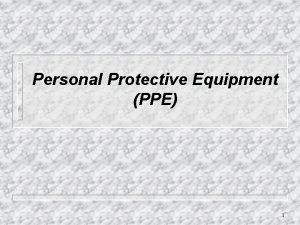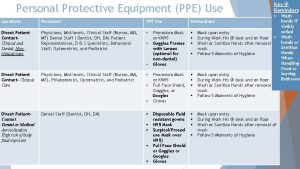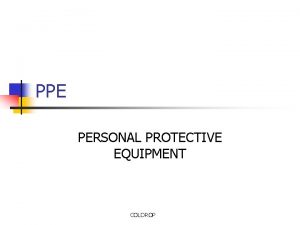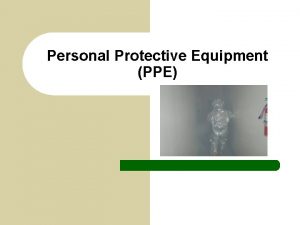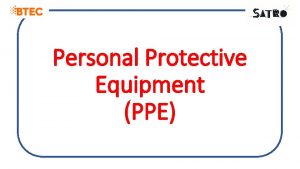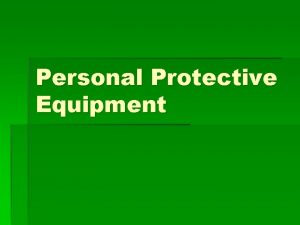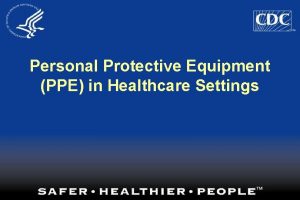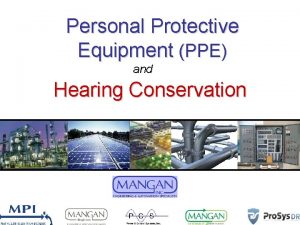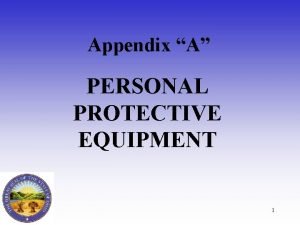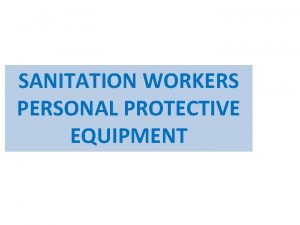Personal Protective Equipment PPE WAC 296 800 160



































- Slides: 35

Personal Protective Equipment (PPE) WAC 296 -800 -160

LEARNING OBJECTIVES After completing this lesson, you will be able to… • Identify PPE that may be used to protect the eyes, face, head, feet, hands, body, and hearing. • List the 3 primary means of protecting employees from the workplace hazards prior to considering PPE • Explain what should be included in PPE training

Protecting Employees from Workplace Hazards Employers must protect employees from workplace hazards such as machines, hazardous substances, and dangerous work procedures that can cause injury. Employers must: Ø Consider other ways to get hazardous jobs done Ø Reduce hazards materials or process Ø Apply engineering controls to reduce or eliminate hazards Remember, PPE is the last level of control!

Provide PPE to Your Employees Employer must provide at no cost to employees if the PPE is: • The type that would not reasonable or normally by worn from the workplace, such as single use or disposable. • Required to comply with a safety and health standard to protect employees wherever hazards exist from: - Processes - Environmental hazards - Physical, chemical, or radiological hazards or - Mechanical irritants that could cause injuries or impairment to the function of any body part through absorption, inhalation, or physical contact.

Engineering Controls If. . . The machine or work environment can be physically changed to prevent employee exposure to the potential hazard, Then. . . The hazard can be eliminated with an engineering control.

Engineering Controls (cont’d) Examples. . . • Initial design specifications • Substitute less harmful material • Change process • Enclose process • Isolate process • Ventilation

Work Practice Controls If. . . Employees can be removed from exposure to the potential hazard by changing the way they do their jobs, Then. . . The hazard can be eliminated with a work practice control.

Work Practice Controls (cont’d) Examples. . . • Use of wet methods to suppress dust • Personal hygiene • Housekeeping and maintenance • Job rotation of workers

Examples of PPE • Eye - safety glasses, goggles • Face - face shields • Head - hard hats • Feet - safety shoes • Hands and arms - gloves • Bodies - vests • Hearing - earplugs, earmuffs

Establishing a PPE Program • Sets out procedures for selecting, providing, and using PPE as part of an employer’s routine operation • First -- assess the workplace to determine if hazards are present, or are likely to be present, which necessitate the use of PPE • Once the proper PPE has been selected, the employer must provide training to each employee who is required to use PPE

Training Employees required to use PPE must be trained to know at least the following: • When PPE is necessary • What type of PPE is necessary • How to properly don, doff, adjust, and wear PPE • Limitations of the PPE • Proper care, maintenance, useful life and disposal

Eye Protection

What are some of the causes of eye injuries? • Dust and other flying particles, such as metal shavings or sawdust • Molten metal that might splash • Acids and other caustic liquid chemicals that might splash • Blood and other potentially infectious body fluids that might splash, spray, or splatter • Intense light such as that created by welding and lasers

Safety Spectacles • Made with metal/plastic safety frames • Most operations require side shields • Used for moderate impact from particles produced by such jobs as carpentry, woodworking, grinding, and scaling

Welding Shields Protect eyes from burns caused by infrared or intense radiant light, and protect face and eyes from flying sparks, metal spatter, and slag chips produced during welding, brazing, soldering, and cutting

LASER Safety Goggles Protect eyes from intense concentrations of light produced by lasers.

Face Shields Protect the face from nuisance dusts and potential splashes or sprays of hazardous liquids It does not protect employees from impact hazards

Head Protection http: //www. bing. com/videos/search? q=PPE&FORM=HDRSC 3#view=detail&mid=A 155 F 6204 C 6 CE 7 D 84901

What are some of the causes of head injuries? • Falling objects • Bumping head against fixed objects, such as exposed pipes or beams • Contact with exposed electrical conductors

Classes of Hard Hats Class G • General service (e. g. , mining, building construction, shipbuilding, lumbering, and manufacturing) • Good impact protection but limited voltage protection Class E • Electrical work • Protect against falling objects, high-voltage shock/burns Class C • Designed for comfort, offer limited protection • Protects heads that may bump against fixed objects, but do not protect against falling objects or electrical shock ANSI Z 89. 1 -1997

Hearing Protection

Examples of Hearing Protectors Earmuffs Earplugs Canal Caps

HEARING TEST http: //www. noiseaddicts. com/2009/03/can-you-hear-this-hearing-test/ http: //www. bing. com/videos/search? q=hearing+and+how+it+workd&& view=detail&mid=9 BB 546 C B 073415 B 251359 BB 546 CB 073415 B 25135&rvsmid=9 BB 546 CB 073415 B 251359 BB 546 CB 07341 5 B 25135&fsscr=0&FORM=VDFSRV

Foot Protection http: //www. bing. com/videos/search? q=PPE&FORM=HDRSC 3#view=detail&mid=25371 F 34 F 97 EAB 64204225371 F 34 F 97 EAB 642042

What are some of the causes of foot injuries? • Heavy objects such as barrels or tools that might roll onto or fall on employees’ feet • Sharp objects such as nails or spikes that might pierce the soles or uppers of ordinary shoes • • • Molten metal that might splash on feet Hot or wet surfaces Slippery surfaces

Safety Shoes • Have impact-resistant toes and heat-resistant soles that protect against hot surfaces common in roofing, paving, and hot metal industries • Some have metal insoles to protect against puncture wounds • May be designed to be electrically conductive for use in explosive atmospheres, or nonconductive to protect from workplace electrical hazards

Hand Protection

What are some of the hand injuries you need to guard against? • Burns • Fractures • Bruises • Amputations • Abrasions • Chemical Exposures • Cuts • Punctures

Types of Gloves Kevlar protects against cuts, slashes and abrasion. Stainless steel mesh protects against cuts and lacerations. Nitrile provides protection against a wide variety of solvents, harsh chemicals, fats and petroleum products and also provides excellent resistance to cuts, snags, punctures and abrasions.

Body Protection

What are some of the causes of body injuries? • • Intense heat Splashes of hot metals and other hot liquids Impacts from tools, machinery, and materials Cuts Hazardous chemicals Contact with potentially infectious materials, like blood Radiation

Body Protection Cooling Vest Sleeves and Apron

Body Protection Full Body Suit Coveralls

Summary Employers must implement a PPE program where they: • • Assess the workplace for hazards • Select and provide appropriate PPE at no cost to employees to protect them from hazards that cannot be eliminated • Inform employees why the PPE is necessary and when it must be worn • Train employees on how to use and care for their PPE and how to recognize deterioration and failure • Require employees to wear selected PPE in the workplace Use engineering and work practice controls to eliminate or reduce hazards before using PPE

Learning Objectives • Identify PPE that may be used to protect the eyes, face, head, feet, hands, body, and hearing. • List the 3 primary means of protecting employees from the workplace hazards prior to considering PPE • Explain what should be included in PPE training Questions?
 Wac 296-800-160
Wac 296-800-160 Wac 296-305
Wac 296-305 Wac 296
Wac 296 Wac 296 155
Wac 296 155 Wac 296-307
Wac 296-307 Wac 296-305
Wac 296-305 Personal protective equipment list
Personal protective equipment list Personal protective equipment summary
Personal protective equipment summary Personal protective equipment vocabulary
Personal protective equipment vocabulary Personal protective equipment program
Personal protective equipment program Ppe in plumbing
Ppe in plumbing Personal protective equipment for farmers
Personal protective equipment for farmers Personal protective equipment pictograms
Personal protective equipment pictograms Who is responsible for providing specialized work footwear?
Who is responsible for providing specialized work footwear? Personal protective equipment safety talk
Personal protective equipment safety talk 6 personal protective equipment
6 personal protective equipment Ppe matrix doc
Ppe matrix doc Welding chapter 2
Welding chapter 2 Ppe for contact precautions
Ppe for contact precautions Personal protective equipment in chemistry laboratory
Personal protective equipment in chemistry laboratory Plumbing safety equipment
Plumbing safety equipment Asbestos personal protective equipment
Asbestos personal protective equipment 800+200+400
800+200+400 Who is responsible for providing specialized work footwear
Who is responsible for providing specialized work footwear Special protective equipment used in firefighting except
Special protective equipment used in firefighting except Equal potential grounding
Equal potential grounding Personal protective factor
Personal protective factor E-296
E-296 Cs 296
Cs 296 Nnpj-296
Nnpj-296 Executari silite mihai bravu
Executari silite mihai bravu Wac 388-877
Wac 388-877 Enrolloffice. com
Enrolloffice. com Wac 181-87
Wac 181-87 Wac kmu
Wac kmu Bumper-wac
Bumper-wac
